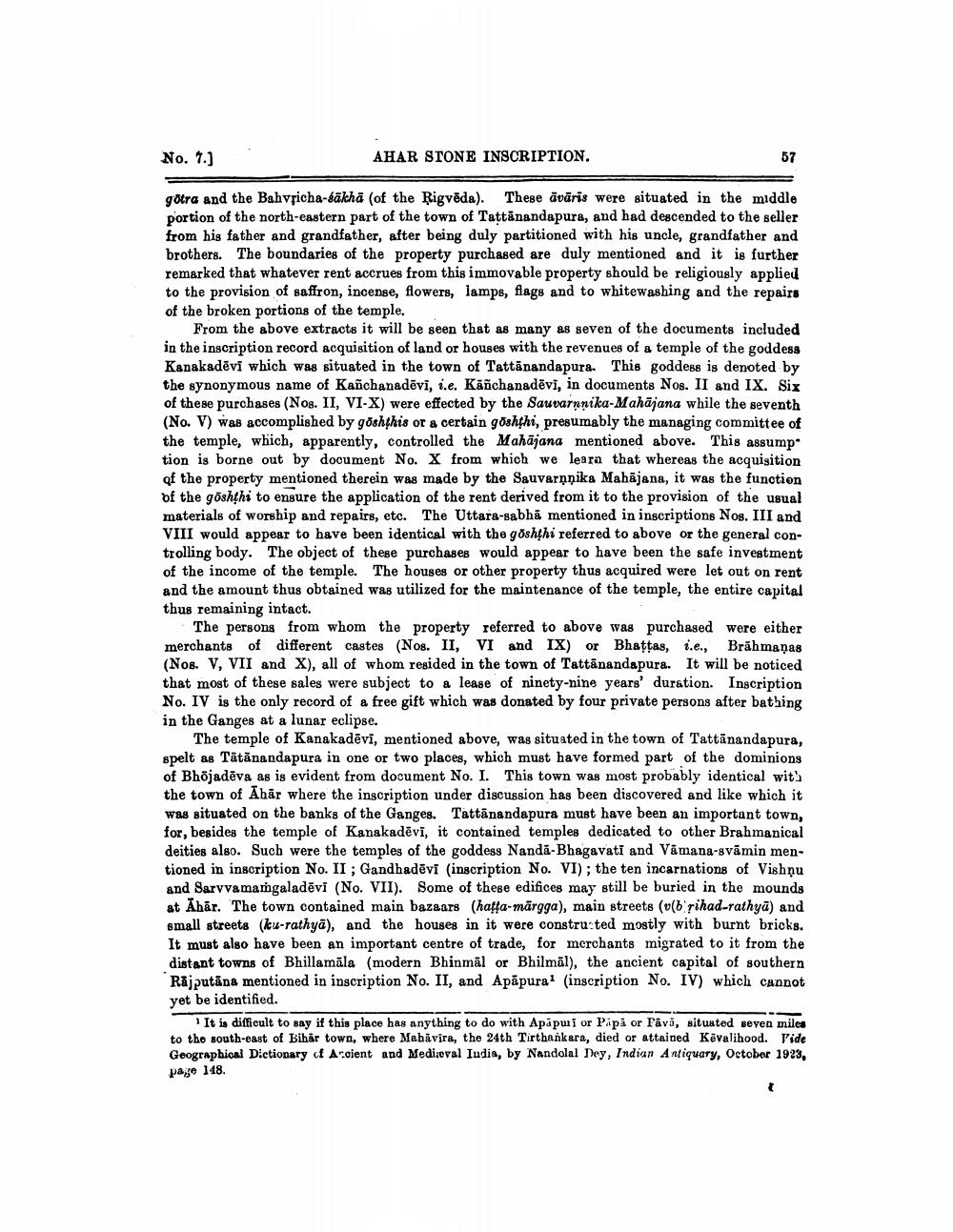________________
No. 7.)
AHAR STONE INSCRIPTION.
götra and the Bahvpicha-sakha (of the Rigvēda). These avāris were situated in the middle portion of the north-eastern part of the town of Tattānandapura, and had descended to the seller from his father and grandfather, after being duly partitioned with his uncle, grandfather and brothers. The boundaries of the property purchased are duly mentioned and it is further remarked that whatever rent accrues from this immovable property should be religiously applied to the provision of saffron, incense, flowers, lamps, flags and to whitewashing and the repairs of the broken portions of the temple.
From the above extracts it will be seen that as many as seven of the documents included in the inscription record acquisition of land or houses with the revenues of a temple of the goddess Kanakadēvi which was situated in the town of Tattānandapura. This goddess is denoted by the synonymous name of Kanchanadēvi, i.e. Kāñchanadēvi, in documents Nos. II and IX. Six of these purchases (Nos. II, VI-X) were effected by the Sauvarnnika-Mahājana while the seventh (No. V) was accomplished by goshthis or a certain goshthi, presumably the managing committee of the temple, which, apparently, controlled the Mahājana mentioned above. This assumpo tion is borne out by document No. X from which we leara that whereas the acquisition of the property mentioned therein was made by the Sauvarạnika Mahājana, it was the function of the goshthi to ensure the application of the rent derived from it to the provision of the usual materials of worship and repairs, etc. The Uttara-sabhā mentioned in inscriptions Nos. III and VIII would appear to have been identical with the goshthi referred to above or the general controlling body. The object of these purchases would appear to have been the safe investment of the income of the temple. The houses or other property thus acquired were let out on rent and the amount thus obtained was utilized for the maintenance of the temple, the entire capital thus remaining intact.
The persons from whom the property referred to above was purchased were either merchants of different castes (Nos. II, VI and IX) or Bhattas, i.e., Brāhmaṇas (Nos. V, VII and X), all of whom resided in the town of Tattānandapura. It will be noticed that most of these sales were subject to a lease of ninety-nine years' duration. Inscription No. IV is the only record of a free gift which was donated by four private persons after bathing in the Ganges at a lunar eclipse.
The temple of Kanakadēvi, mentioned above, was situated in the town of Tattānandapura, spelt as Tātānandapura in one or two places, which must have formed part of the dominions of Bhõjadēva as is evident from document No. I. This town was most probably identical wit) the town of Ahär where the inscription under discussion has been discovered and like which it was situated on the banks of the Ganges. Tattānandapura must have been an important town, for, besides the temple of Kanakadēvi, it contained temples dedicated to other Brahmanical deities also. Such were the temples of the goddess Nanda-Bhagavati and Vāmana-svāmin mentioned in inscription No. II ; Gandhadēvi (inscription No. VI); the ten incarnations of Vishņu and Sarvvamamgaladēvi (No. VII). Some of these edifices may still be buried in the mounds at Ahär. The town contained main bazaars (hatļa-märgga), main streets (u(b pihad-rathyā) and small streets (ku-rathyā), and the houses in it were constructed mostly with burnt bricks. It must also have been an important centre of trade, for merchants migrated to it from the distant towns of Bhillamäla (modern Bhinmāl or Bhilmäl), the ancient capital of southern Rajputāna mentioned in inscription No. II, and Apăpura (inscription No. IV) which cannot yet be identified.
It is difficult to say if this place has anything to do with Apapui or Papà or Pāvā, situated seven miles to the south-east of Bihar town, where Mabāvira, the 24th Tirthankara, died or attained Kēvalihood. Vide Geographical Dictionary of Accient and Medieval Iudia, by Nandolal Dey, Indian Antiquary, October 1923, Page 148.




